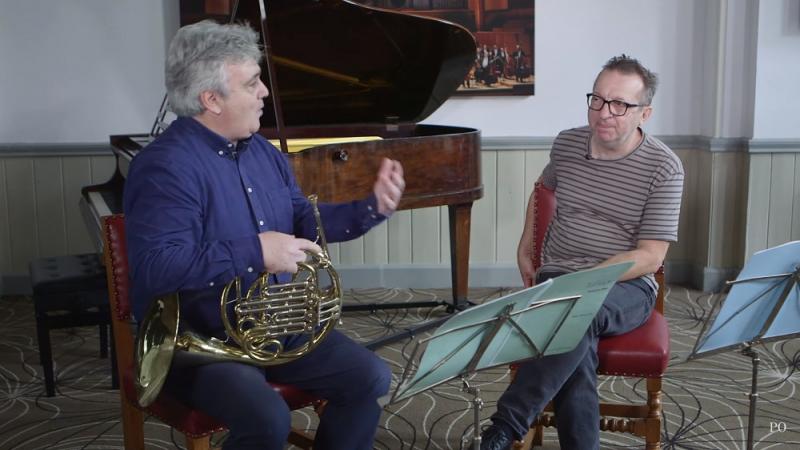Watkins, Clayton, Philharmonia, Salonen, RFH review - a rainbow cornucopia | reviews, news & interviews
Watkins, Clayton, Philharmonia, Salonen, RFH review - a rainbow cornucopia
Watkins, Clayton, Philharmonia, Salonen, RFH review - a rainbow cornucopia
A modest new masterpiece by Mark-Anthony Turnage fits snugly in a perfect programme

Horns fanfared, coasted and chorused through yet another Philharmonia winner of a concert to match the impressive planning of its Weimar season last year and no doubt a plan close to the heart of principal conductor Esa-Pekka Salonen, who started his musical life as a horn-player.
If Britten's highest poetry in the setting of Keats's Sonnet "To Sleep" was the moment when the evening's musicianship most consistently sounded the depths – divided Philharmonia strings as much as Clayton making the eyes prick with tears – Turnage came close in the second movement of To Alba, homaging Philip Larkin's "Aubade". It was telling to learn in the helpful programme note that the composer often sets instrumental lines to poetic text before removing the words: perusing the score after the concert, I could see that the opening horn line of the jaunty finale does indeed fit Donne's "Busy old fool, unruly sun,/ Why dost thou thus/ Through windows, and through curtains call on us?", though that didn't seem to apply to Turnage and Larkin.
No matter; the essence is what matters, and this is a concerto that arrests from the opening horn gesture, riffed about, never outstaying its welcome: a great British specimen to follow James MacMillan's superb essays in the genre. There's humour here too: just as trumpets cap a high watermark of excitement in the finale, the ensemble cuts off, the soloist seems about to embark on a cadenza – and then it all stops with a flourish.  If lyricism is encased within lolloping, lilting exuberance here, the method is turned inside out by Britten in the perfection of the Serenade, its delicious Tennyson and Jonson settings scherzo-interludes in a work that's as much the essence of the English evening as the art of Samuel Palmer. Watkins tells us that the tenor for whom it was written, Britten's life-partner Peter Pears, answered when he asked about the solo Prologue, with its natural harmonics adding a dimension of strangeness, "imagine that you are standing upon the moon".
If lyricism is encased within lolloping, lilting exuberance here, the method is turned inside out by Britten in the perfection of the Serenade, its delicious Tennyson and Jonson settings scherzo-interludes in a work that's as much the essence of the English evening as the art of Samuel Palmer. Watkins tells us that the tenor for whom it was written, Britten's life-partner Peter Pears, answered when he asked about the solo Prologue, with its natural harmonics adding a dimension of strangeness, "imagine that you are standing upon the moon".
Clayton (pictured above by Sim Canetty-Clarke) occupied the same air from another world, slivering the sound instrumentally at first, pulling out the flesh-creep stops for the climax of the "Lyke-Wake Dirge" – something beyond several choral-scholar exponents of an older generation. And Salonen made sure we noticed Britten's stunning writing for what was here a large body of strings, bass pizzicati like another voice in Blake's "The Sick Rose".
It was also, as carefully planned, a good evening for the Philharmonia horns, led last night by Diego Incertis Sánchez. The famous solo in Till Eulenspiegel had all the time it needed on its first run, though Salonen seemed so determined to play up, as in slow down, contrasts to the general rondo buoyancy such as the moment the mocker gets an intimation of his own untimely end that I wondered if oboist Timothy Rundle had missed his cue. For me, the best Tills are those where the momentum never really slackens, where the spring remains wound up. Granting Salonen his interpretative quirkness, though, it was all superbly executed, a rip-roaring end to a programme that worked even better in practice than on paper.
rating
Share this article
The future of Arts Journalism
You can stop theartsdesk.com closing!
We urgently need financing to survive. Our fundraising drive has thus far raised £49,000 but we need to reach £100,000 or we will be forced to close. Please contribute here: https://gofund.me/c3f6033d
And if you can forward this information to anyone who might assist, we’d be grateful.

Subscribe to theartsdesk.com
Thank you for continuing to read our work on theartsdesk.com. For unlimited access to every article in its entirety, including our archive of more than 15,000 pieces, we're asking for £5 per month or £40 per year. We feel it's a very good deal, and hope you do too.
To take a subscription now simply click here.
And if you're looking for that extra gift for a friend or family member, why not treat them to a theartsdesk.com gift subscription?
more Classical music
 Willis-Sørensen, Ukrainian Freedom Orchestra, Wilson, Cadogan Hall review - romantic resilience
Passion, and polish, from Kyiv's musical warriors
Willis-Sørensen, Ukrainian Freedom Orchestra, Wilson, Cadogan Hall review - romantic resilience
Passion, and polish, from Kyiv's musical warriors
 BBC Proms: The Marriage of Figaro, Glyndebourne Festival review - merriment and menace
Strong Proms transfer for a robust and affecting show
BBC Proms: The Marriage of Figaro, Glyndebourne Festival review - merriment and menace
Strong Proms transfer for a robust and affecting show
 BBC Proms: Faust, Gewandhausorchester Leipzig, Nelsons review - grace, then grandeur
A great fiddler lightens a dense orchestral palette
BBC Proms: Faust, Gewandhausorchester Leipzig, Nelsons review - grace, then grandeur
A great fiddler lightens a dense orchestral palette
 BBC Proms: Jansen, Royal Concertgebouw Orchestra, Mäkelä review - confirming a phenomenon
Second Prom of a great orchestra and chief conductor in waiting never puts a foot wrong
BBC Proms: Jansen, Royal Concertgebouw Orchestra, Mäkelä review - confirming a phenomenon
Second Prom of a great orchestra and chief conductor in waiting never puts a foot wrong
 BBC Proms: Royal Concertgebouw Orchestra, Mäkelä review - defiantly introverted Mahler 5 gives food for thought
Chief Conductor in Waiting has supple, nuanced chemistry with a great orchestra
BBC Proms: Royal Concertgebouw Orchestra, Mäkelä review - defiantly introverted Mahler 5 gives food for thought
Chief Conductor in Waiting has supple, nuanced chemistry with a great orchestra
 Dunedin Consort, Butt / D’Angelo, Muñoz, Edinburgh International Festival 2025 review - tedious Handel, directionless song recital
Ho-hum 'comic' cantata, and a song recital needing more than a beautiful voice
Dunedin Consort, Butt / D’Angelo, Muñoz, Edinburgh International Festival 2025 review - tedious Handel, directionless song recital
Ho-hum 'comic' cantata, and a song recital needing more than a beautiful voice
 Classical CDs: Dungeons, microtones and psychic distress
This year's big anniversary celebrated with a pair of boxes, plus clarinets, pianos and sacred music
Classical CDs: Dungeons, microtones and psychic distress
This year's big anniversary celebrated with a pair of boxes, plus clarinets, pianos and sacred music
 BBC Proms: Liu, Philharmonia, Rouvali review - fine-tuned Tchaikovsky epic
Sounds perfectly finessed in a colourful cornucopia
BBC Proms: Liu, Philharmonia, Rouvali review - fine-tuned Tchaikovsky epic
Sounds perfectly finessed in a colourful cornucopia
 BBC Proms: Suor Angelica, LSO, Pappano review - earthly passion, heavenly grief
A Sister to remember blesses Puccini's convent tragedy
BBC Proms: Suor Angelica, LSO, Pappano review - earthly passion, heavenly grief
A Sister to remember blesses Puccini's convent tragedy
 BBC Proms: A Mass of Life, BBCSO, Elder review - a subtle guide to Delius's Nietzschean masterpiece
Mark Elder held back from blasting the audience with a wall of sound
BBC Proms: A Mass of Life, BBCSO, Elder review - a subtle guide to Delius's Nietzschean masterpiece
Mark Elder held back from blasting the audience with a wall of sound
 BBC Proms: Le Concert Spirituel, Niquet review - super-sized polyphonic rarities
Monumental works don't quite make for monumental sounds in the Royal Albert Hall
BBC Proms: Le Concert Spirituel, Niquet review - super-sized polyphonic rarities
Monumental works don't quite make for monumental sounds in the Royal Albert Hall
 Frang, Romaniw, Liverman, LSO, Pappano, Edinburgh International Festival 2025 review - sunlight, salt spray, Sea Symphony
Full force of the midday sea in the Usher Hall, thanks to the best captain at the helm
Frang, Romaniw, Liverman, LSO, Pappano, Edinburgh International Festival 2025 review - sunlight, salt spray, Sea Symphony
Full force of the midday sea in the Usher Hall, thanks to the best captain at the helm

Add comment